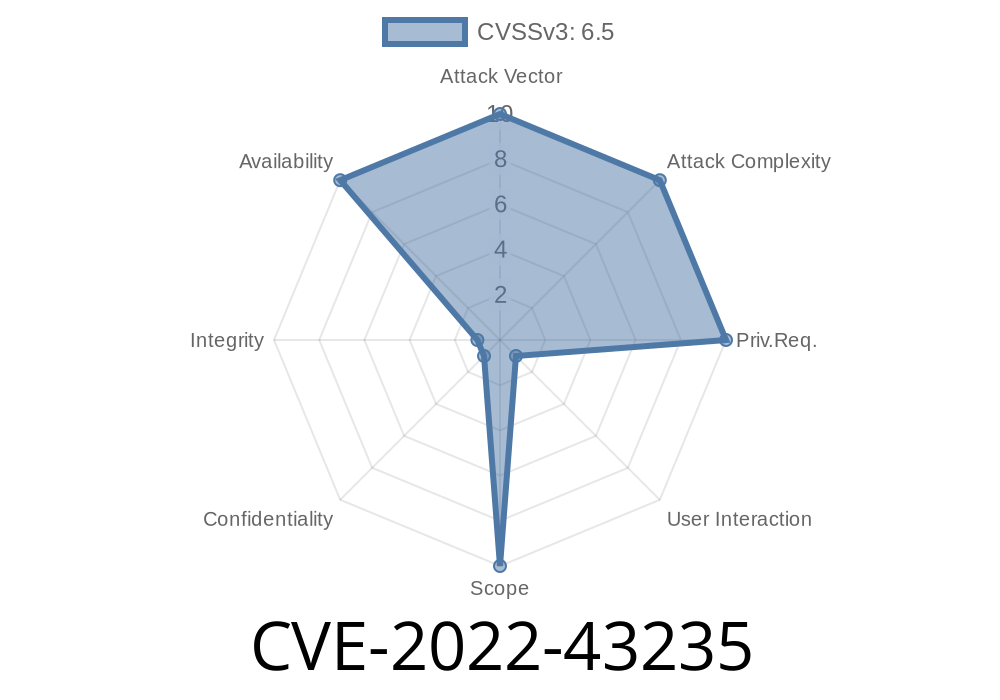In the realm of software security, vulnerabilities constantly pose challenges to developers and users alike. Recently, a heap-buffer-overflow vulnerability has been discovered within the video codecs of libde265 v1..8. This post aims to provide a detailed description of the exploit, the background of the software, the vulnerability's impact, and code snippets that will help decipher the problem. Inclusive of references, this composition discloses how an attacker may use a malicious video file to cause Denial of Service (DoS) and potentially access other data.
Background on libde265 and CVE-2022-43235
For those unfamiliar, libde265 is an open-source implementation of the H.265/HEVC (High Efficiency Video Coding) video codec, developed by the Struktur AG team and utilized in various video streaming applications. The discovered vulnerability, CVE-2022-43235, specifically affects version 1..8 of libde265 and its implementation in the ff_hevc_put_hevc_epel_pixels_8_sse function in the sse-motion.cc file.
The Vulnerability's Impact
The heap-buffer-overflow vulnerability allows attackers to crash the multimedia application using libde265, causing a DoS attack. These attacks can be performed by enticing a user to open a specially crafted video file that contains malicious packets. In some cases, the vulnerability may further provide attackers access to unauthorized data.
Exploring the Code
To provide a better understanding of the vulnerability, let's dive into a code snippet from the sse-motion.cc file that entails the ff_hevc_put_hevc_epel_pixels_8_sse function:
void ff_hevc_put_hevc_epel_pixels_8_sse(int16_t *dst, ptrdiff_t dststride,
uint8_t *src, ptrdiff_t srcstride,
int width, int height, int mx, int my,
int16_t* mcbuffer) {
int shift_rounding = (1 << (EPEL_EXTRA_BEFORE_SHIFT))-1;
DECLARE_ALIGNED(32, int16_t, filter_coeffs[4][8]) = {
...
Here, the function is designed to handle video frames that require interpolation in the horizontal and vertical directions. The vulnerability occurs due to improper validation of input video parameters leading to a buffer overflow and, consequently, a crash in the multimedia application that uses the defective function.
Exploit Details
To exploit this vulnerability, an attacker needs to craft a video file that triggers the heap-buffer-overflow in the target system running libde265 v1..8. By doing so, the attacker can execute a DoS attack on the target application and possibly gain access to unauthorized information.
The primary prerequisite for a successful exploit is that the target system must run libde265 v1..8. Beyond this, attackers must devise a strategy to convince users to open the malicious video files, often achieved through social engineering tactics.
Original References
The CVE-2022-43235 vulnerability was originally reported by researchers in the following public advisory:
* CVE-2022-43235 (libde265 Heap Buffer Overflow Vulnerability)
* NIST National Vulnerability Database (NVD) Entry
Conclusion
With the identification of the CVE-2022-43235 vulnerability in libde265 v1..8, it becomes imperative for developers and users to be aware of potential security risks. Taking steps to patch the issue, scrutinize the usage of video codecs in their applications, and perform thorough validation processes for video parameters becomes necessary. By staying informed, staying proactive, and consistently applying the proper solutions, users and developers can better safeguard against such vulnerabilities.
Timeline
Published on: 11/02/2022 14:15:00 UTC
Last modified on: 02/27/2023 15:17:00 UTC
